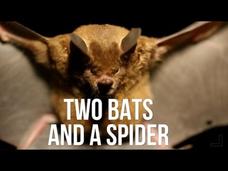Curated OER
Jurassic Fight Club: T-Rex vs. Raptors - Part 1/2
Fight or flight response and physical prowess is examined in this seven-minute video. Using evidence and a knowledge of animal behavior, scientists were able to show how the bird-like raptor attacked its prey. Studying dinosaur behavior...
Deep Look
What Happens When You Put a Hummingbird in a Wind Tunnel?
Hummingbirds consume their weight in nectar every day. The video explains their unusual flying abilities. From holding their bodies perfectly still while flapping their wings in mid air in order to get the nectar to shaking off water...
MinuteEarth
Why Don't Scavengers Get Sick?
Scavengers eat diseased animals, yet don't get sick. The video explores this topic through examples of vultures and beetles. One method sprays the decaying meat prior to eating. The other method relies on strong stomach acid to break...
The Brain Scoop
Two Bats and a Spider
What creatures lurk in the rainforest at night? Meet three of them in one short video. Part of a playlist exploring mammals, the video presents a look at night research in the Amazon. Scientists locate and photograph two bat species and...
TED-Ed
How We Think Complex Cells Evolved
Being able to absorb the abilities of other life forms may seem like something taken from a superhero movie, but sometimes reality is stranger than fiction. Join the narrator as he takes viewers back billions of years to investigate how...
Crash Course
Natural Selection
The peppered moth is featured in a video about natural selection. The narrator tells the story of Darwin's theory and then moves on to the principles behind natural selection and the different ways it works. Concepts covered include...
Be Smart
Why Do More Species Live Near the Equator?
The tropics contain about 40 percent of the area on Earth. Viewers take a trip to Peru as an entrancing video from a larger biology playlist explores the region. It explains the facts and theories about the biodiversity near the equator....
MinuteEarth
Are any Animals Truly Monogamous?
Known for being one of the few monogamous animals, Diplozoon paradoxum live on fishgills. The video details animals that appear monogamous and the research on their mating habits. From open polygamy to cheating, various species strive...
ABCmouse
Count to Ten
Reinforce counting skills with a captivating music video that follows a young boy and his dog as they explore the outdoors, all the while a choir of children count to 10 to the tune of This Old Man.
Kurzgesagt – In a Nutshell
What is Dark Matter and Dark Energy?
All matter in the universe only adds up to five percent of the universe — the video explains the other 95 percent. It describes what we know about dark matter and dark energy. With more to learn, scientists share the excitement of their...
The Brain Scoop
Where'd You Get All Those Dead Animals?
Why do zoologists collect animal specimens for research? And, how many animals is enough? Explore both sides of a current debate in the scientific community using a video that is part of a larger playlist on mammals. Topics include where...
Crash Course
Using Wikipedia: Crash Course Navigating Digital Information #5
Wikipedia may get a bad rap, but does it have any redeeming qualities? As it turns out, it does, and scholars discover what they are with part five from the Crash Course: Navigating Digital Information video series. Pupils learn about...
SciShow
Circadian Rhythm and Your Brain's Clock
Your class will not drift off to sleep during this episode on circadian rhythms. Though the narrator speaks quickly and continuously, he successfully explains our biological clock in a way that holds interest. Assign the viewing of this...
Crash Course
Comparative Anatomy: What Makes Us Animals
What makes animals, well, animals? Viewers of a via comparative anatomy video see how similarities and differences in animal anatomy help support the theory of evolution. The video also includes examples of shared characteristics in...
Crash Course
Fungi: Death Becomes Them
Death becomes fungi because many are decomposers, breaking down dead organisms and returning nutrients to the soil. Explore the fascinating world of fungi, how they feed, the different types, and how they reproduce in a video that also...
SciShow
Prions: The Real Zombie-Makers
Zombies eat your brain, and so do prions. The video explains the similarities between zombies and prions. It then focuses on the way prions form, spread, and the dangers associated with them. It concludes with common prion illnesses and...
ABCMouse
Continents and Oceans
Play a fun video that plants the five oceans and seven continents into young learners brains. The video first goes through the continents in alphabetical order, and then the five oceans in alphabetical order.
MinuteEarth
Invasion of the Yellow Crazy Ants!
How much does an invasive species really matter? The video focuses on examples of accidental species spread as well as intentional introductions. It highlights the problems caused by spreading new plants and animals to areas with no...
MinuteEarth
Why Are Snakes So Creepy?
Humans are predisposed to fear snakes. Through evolution, many animals developed a visceral reaction to snakes as a defense mechanism. An engaging video lesson describes the evidence and how scientists came to this conclusion.
MinuteEarth
Garbage Doesn't Lie
What does your garbage say about you? Young scientists dig through a video about things people cast aside. The narrator shows the fascinating things in George Washington's garbage pile, ancient Roman garbage, and how the landfills we...
Deep Look
Can A Thousand Tiny Swarming Robots Outsmart Nature?
Kilobots, made from only $15 worth of parts, work together to achieve a group goal. The video explains how with a few simple lines of programming, these tiny robots tackle tasks in much the same way animals or cells have for centuries....
Deep Look
The Bombardier Beetle And Its Crazy Chemical Cannon
Named for the soldiers who operated artillery cannons, the bombardier beetle operates a cannon of its own. The video explains how it sets off a chemical reaction creating a small explosion they can aim at a predator. The evolution of the...
Teacher's Pet
Types of Natural Selection
Natural selection—good things come to those who mate. The video introduces the idea of natural selection. Then it details three types: directional, stabilizing, and disruptive. It includes both graphs and examples for each type.
Teacher's Pet
Introduction to Ecology
An educational video offers an overview of ecology and discusses the levels of organization from biosphere down to organisms. It also compares terms such as habitats versus niches, generalist versus specialist, and biotic versus abiotic.

























